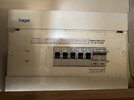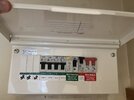- Joined
- 14 Aug 2007
- Messages
- 253
- Reaction score
- 7
- Country

Hi all, I am renting my property soon and would need to do an EICR. however, I don't want someone to come over and force me into replacing the fuse board if it's not required.
The property was built in the 1990's, I have attached a pic of the current fuse board. Can someone tell me if this would need replacing?
No alternations have been carried out to the property since it was built.
Thanks all.
The property was built in the 1990's, I have attached a pic of the current fuse board. Can someone tell me if this would need replacing?
No alternations have been carried out to the property since it was built.
Thanks all.


